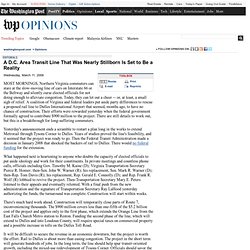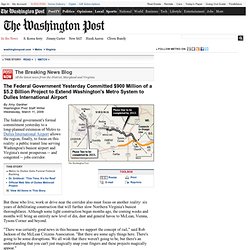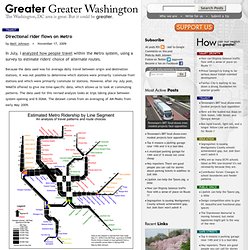

A D.C. Area Transit Line That Was Nearly Stillborn Is Set to Be. MOST MORNINGS, Northern Virginia commuters can stare at the slow-moving line of cars on Interstate 66 or the Beltway and silently curse elected officials for not doing enough to alleviate congestion.

Today, they can let out a cheer -- or, at least, a small sigh of relief. A coalition of Virginia and federal leaders put aside party differences to rescue a proposed rail line to Dulles International Airport that seemed, months ago, to have no chance of construction. Their efforts were rewarded yesterday when the federal government formally agreed to contribute $900 million to the project. There are still details to work out, but this is a breakthrough for long-suffering commuters. Yesterday's announcement ends a scramble to restart a plan long in the works to extend Metrorail through Tysons Corner to Dulles. What happened next is heartening to anyone who doubts the capacity of elected officials to put aside ideology and work for their constituents. There's much hard work ahead. The Federal Government Yesterday Committed $900 Million of a $5. The federal government's formal commitment yesterday to a long-planned extension of Metro to Dulles International Airport allows the region, finally, to focus on this reality: a public transit line serving Washington's busiest airport and Virginia's most prosperous -- and congested -- jobs corridor.

But those who live, work or drive near the corridor also must focus on another reality: six years of debilitating construction that will further slow Northern Virginia's busiest thoroughfares. Although some light construction began months ago, the coming weeks and months will bring an entirely new level of din, dust and general havoc to McLean, Vienna, Tysons Corner and beyond. "There was certainly good news in this because we support the concept of rail," said Rob Jackson of the McLean Citizens Association.
"But there are some ugly things here. There's going to be some disruptions. U.S. "We in Virginia are fortunate to have Dulles . . . to connect us to the world," Kaine said. Directional rider flows on Metro. Transit by Matt Johnson • November 17, 2009 In July, I analyzed how people travel within the Metro system, using a survey to estimate riders' choice of alternate routes.

Because the data used was for average daily travel between origin and destination stations, it was not possible to determine which stations were primarily 'commute from' stations and which were primarily 'commute to' stations. However, after my July post, WMATA offered to give me time-specific data, which allows us to look at commuting patterns. The data used for this revised analysis looks at trips taking place between system opening and 9:30AM. Click to enlarge. The methodology used to assign trips to each link in the system is the same used for the initial model and analysis, published in July. From the graphic it is clear that, not surprisingly, most AM peak trips on Metro are inbound. This analysis also gives us a good estimate of the proportion of passengers traveling on different lines at the junction points.